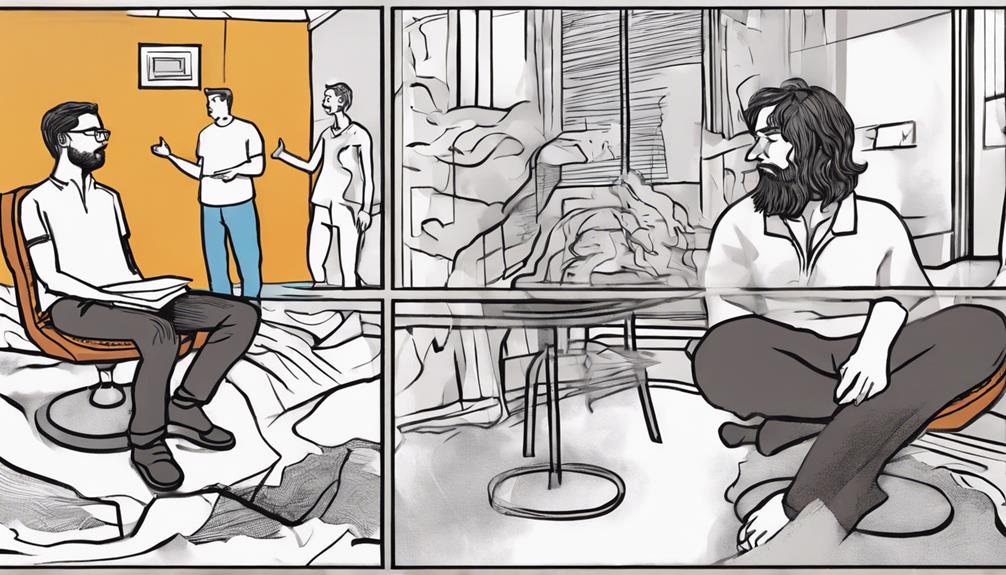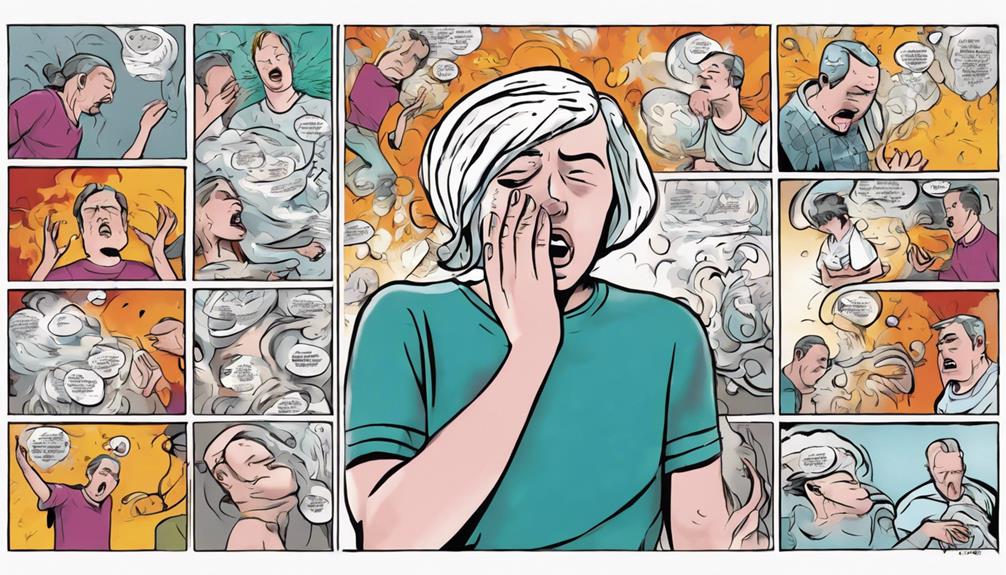Somatic Therapy
Is CBT Somatic Therapy? Differences Explained!
Keep exploring the differences between CBT and somatic therapy to uncover which approach aligns best with your needs and preferences.

When looking at the differences between CBT and somatic therapy, it’s important to note that CBT aims to alter thought patterns and behaviors through mental strategies, whereas somatic therapy focuses on the body’s physical sensations and the trauma it holds. CBT addresses cognitive distortions, and somatic therapy works to free trauma energy through the autonomic nervous system. Each method has its strengths and uses different techniques. Continue to investigate to figure out which modality could best serve you according to your personal requirements and ease.
Key Takeaways
- CBT focuses on changing thoughts and behaviors, while somatic therapy targets physical sensations and trauma energy.
- CBT uses cognitive restructuring, while somatic therapy works with the autonomic nervous system to discharge trauma energy.
- CBT aims to reframe cognitive distortions, whereas somatic therapy listens to body signals for healing.
- CBT alleviates stress and anxiety through cognitive processes, while somatic therapy addresses trauma stored in the body.
- Combining CBT with somatic techniques offers a comprehensive approach to healing by integrating cognitive and bodily responses.
Defining CBT and Somatic Therapy
When differentiating CBT and somatic therapy, it's essential to understand their distinct approaches to mental health treatment.
Cognitive Behavioral Therapy (CBT) is a form of talk therapy that focuses on changing negative thoughts and behaviors. It targets cognitive processes and behaviors, aiming to reframe cognitive distortions and change behavior through cognitive restructuring techniques.
On the other hand, somatic therapy, including modalities like Somatic Experiencing™, emphasizes the body's role in healing and trauma resolution. Somatic therapy works with the body's sensations and responses to address trauma and stress by releasing stored trauma energy.
While both CBT and somatic therapy are effective in treating mental health issues, they differ in their approaches to psychological distress. CBT primarily addresses thoughts and behaviors, while somatic therapy focuses on the body's involvement in healing and resolving trauma.
Understanding these distinctions can help individuals choose the therapeutic modality that best suits their needs and preferences.
Contrasting Therapeutic Approaches

To contrast the therapeutic approaches of CBT and somatic therapy, it is important to understand their distinct focuses and methodologies. Cognitive therapy (CBT) primarily targets changing thought patterns and behaviors, aiming to modify negative cognitive processes. On the other hand, somatic therapy, such as Somatic Experiencing, focuses on physical sensations and responses within the body, addressing trauma energy stored in the body's tissues. One key difference lies in how these approaches engage with trauma; somatic therapy aims to discharge stored trauma energy from the body by working with the autonomic nervous system, while CBT concentrates on altering cognitive processes related to trauma. Below is a table highlighting the key differences between CBT and somatic therapy:
| Therapeutic Approach | Focus |
|---|---|
| Cognitive Therapy (CBT) | Changing thought patterns and behaviors |
| Somatic Therapy | Addressing physical sensations and trauma energy stored in the body |
Understanding Core Differences

Let's explore the fundamental distinctions between CBT and Somatic Therapy to grasp their core differences.
CBT, a widely used mental health therapy, focuses on restructuring negative thoughts and behaviors to alleviate symptoms like stress and anxiety. In a CBT therapy session, you and your therapist collaboratively work to identify and challenge distorted thinking patterns within your window of tolerance. CBT techniques involve cognitive restructuring and behavioral activation.
On the other hand, Somatic Therapy, a body-centered healing modality, emphasizes the importance of the body in trauma resolution through techniques like Somatic Experiencing. In Somatic Therapy, you're encouraged to listen to your body's signals and sensations to create change and regulate your nervous system. Somatic Therapy incorporates grounding exercises, breathing techniques, and movement to release stored trauma.
Exploring Therapeutic Techniques

Exploring various therapeutic techniques in CBT and somatic therapy reveals the diverse approaches used in each modality for healing and growth.
In CBT, techniques like Eye Movement Desensitization and Reprocessing (EMDR) focus on reprocessing traumatic memories through bilateral stimulation.
On the other hand, somatic therapy methods, such as Somatic Experiencing and Sensorimotor Psychotherapy, prioritize bodily sensations and nervous system responses to resolve trauma.
The Hakomi Method, a body-centered psychotherapy, emphasizes mindfulness and non-verbal cues to address deep-seated emotional patterns.
Understanding that the body keeps the score of past traumas, somatic therapy techniques involve tracking bodily sensations and facilitating the release of stored trauma energy.
While CBT primarily addresses thoughts and behaviors, somatic therapy integrates body awareness and sensations for holistic healing.
Combining CBT with somatic techniques offers a comprehensive approach to addressing both cognitive and somatic aspects of healing, providing a more integrated and effective treatment plan.
Considerations for Effective Treatment

Considering the individual's specific needs and preferences is essential for effective treatment when choosing between CBT and Somatic Therapy. CBT, focusing on changing negative thought patterns and behaviors, may suit those inclined towards cognitive approaches.
On the other hand, Somatic Therapy, which emphasizes the body's role in trauma processing and healing, might be more beneficial for individuals seeking to address trauma through body-centered techniques. If you resonate with exploring body sensations, movement, and nervous system regulation to release stored trauma energy, Somatic Therapy could be a suitable choice.
In contrast, if you prefer a more talk-based and cognitive approach, CBT may be more aligned with your preferences. Understanding these distinctions and reflecting on how you connect with therapeutic methods can guide you in selecting the most appropriate approach for your unique healing journey. Remember, the effectiveness of treatment greatly depends on how well it aligns with your individual needs and comfort level.
Frequently Asked Questions
What Is the Opposite of Somatic Therapy?
The opposite of somatic therapy is cognitive-behavioral therapy (CBT). CBT focuses on changing negative thought patterns and behaviors, while somatic therapy emphasizes the body's role in healing trauma through sensations and movements.
How Is Cognitive Behavioral Therapy Different From Other Psychotherapies?
In the vast field of psychotherapies, Cognitive Behavioral Therapy stands out by actively challenging negative thoughts and behaviors. Imagine a sculptor carving away at a block of marble, shaping your mind towards positivity.
What Is the Difference Between CBT and Systemic Therapy?
In systemic therapy, you focus on family dynamics and relationships, addressing patterns of interaction. CBT, on the other hand, targets individual thoughts and behaviors. Both approaches offer unique perspectives on understanding and improving mental health.
What Are the Criticisms of Somatic Experiencing?
Critics question Somatic Experiencing's efficacy, evidence base, theoretical foundations, and focus on physical sensations for trauma healing. Some argue it may not address all trauma aspects or suit everyone, sparking debates within the field.
Conclusion
To wrap up, while CBT focuses on changing thoughts and behaviors, somatic therapy targets physical sensations and emotions.
As the saying goes, 'different strokes for different folks.' Both approaches offer unique strategies for addressing mental health concerns.
By understanding the core differences and exploring various therapeutic techniques, individuals can find the most effective treatment that resonates with their needs and experiences.
Remember, the path to healing is as diverse as the individuals seeking it.
Somatic Therapy
Is DBT Somatic Therapy? Find Out Here!
Intrigued to learn if DBT is somatic therapy? Uncover its holistic approach to mental health and the integration of somatic elements.

DBT does not classify as somatic therapy, but it does embrace somatic components to support a comprehensive mental health strategy. This approach melds behavioral with humanistic methods, highlighting the mind-body connection. Although DBT is not strictly somatic, it recognizes the importance of physical activities such as yoga and meditation in promoting general health. To grasp more about DBT’s incorporation of somatic elements, explore its principles and methods for a complete insight into its holistic approach towards mental health.
Key Takeaways
- DBT is not solely somatic therapy.
- DBT integrates behavioral and humanistic interventions.
- Somatic therapy emphasizes the mind-body connection.
- DBT focuses on mindfulness skills and emotional regulation.
- While related, DBT and somatic therapy have distinct approaches.
DBT Origins and Development
DBT Somatic Therapy originated and was developed by Marsha Linehan in the late 1970s. Marsha Linehan, a psychologist, created DBT initially for highly suicidal individuals. The therapy combines behavioral and humanistic interventions, aiming to find a balance between fostering change and promoting acceptance.
One of the central aspects of DBT is the integration of mindfulness skills. These skills encourage individuals to hold apparent contradictions simultaneously, helping them navigate complex emotional experiences effectively. Through DBT, individuals aim to cultivate what's known as a Wise Mind, where emotional experiences and rationality are merged for optimal mental health outcomes.
Marsha Linehan's pioneering work in developing DBT has transformed the field of psychology, offering a unique and effective approach to addressing self-harming behaviors and promoting overall well-being.
Core Principles of DBT

Let's now explore the core principles of DBT.
DBT emphasizes the importance of finding a balance between change and acceptance while incorporating mindfulness skills.
It also highlights the significance of holding contradictions and validating others' experiences to promote healing and growth.
Understanding these principles is crucial for integrating DBT effectively into somatic therapy practices.
DBT and Somatic Therapy
When exploring the core principles of DBT and somatic therapy, it becomes evident that their combined focus on the mind-body connection offers a holistic approach to mental health treatment. DBT, known as Dialectical Behavioral Therapy, integrates behavioral and humanistic interventions to address mental health issues. On the other hand, somatic therapy emphasizes the interconnectedness of thoughts, emotions, and sensations, aiming for holistic healing. Both approaches incorporate physical and psychological techniques to help individuals achieve mental wellness.
In DBT, finding a balance between change and acceptance is key, while somatic therapy focuses on addressing mental health through a comprehensive lens. DBT places a strong emphasis on mindfulness skills, teaching individuals to be present and aware of their thoughts and emotions.
In contrast, somatic therapy may involve physical practices like yoga, meditation, and bodywork to help individuals connect with their bodies and alleviate psychological distress. Together, DBT and somatic therapy offer a holistic approach that integrates both mental and physical well-being.
Key Differences Explained
Understanding the core principles of Dialectical Behavioral Therapy (DBT) involves recognizing key differences that set it apart in mental health treatment approaches. DBT emphasizes a delicate balance between acceptance and change when addressing various mental health conditions.
It incorporates mindfulness skills as a fundamental practice to promote self-awareness and emotional regulation. One of the unique aspects of DBT is its focus on cultivating a Wise Mind, which combines emotional experience with rationality to make balanced decisions. This therapy encourages individuals to hold apparent contradictions simultaneously, fostering understanding and personal growth.
Unlike traditional therapeutic approaches, DBT doesn't view acceptance and change as opposing forces but rather as complementary elements in the healing process. Initially developed for highly suicidal individuals, DBT has gained widespread acceptance for treating a range of mental health conditions by integrating the principles of acceptance and change with self-awareness and emotional regulation.
Integrating Healing Practices
Incorporating healing practices into Dialectical Behavioral Therapy (DBT) involves integrating cognitive, emotional, and behavioral techniques to promote holistic well-being. DBT emphasizes the mind-body connection by focusing on holistic healing, which includes distress tolerance, emotional regulation, and interpersonal effectiveness.
Healing practices within DBT aim to help individuals develop cognitive healing by becoming more aware of their thoughts, emotions, and behaviors. By learning to regulate emotions effectively, individuals can cultivate a Wise Mind, which combines rational thinking with emotional wisdom. The integration of healing practices in DBT emphasizes the importance of balancing acceptance and change to promote overall well-being.
Through these techniques, individuals can develop skills to manage distress, improve relationships, and enhance their emotional well-being. By incorporating these healing practices, DBT offers a thorough approach to addressing emotional pain and promoting personal growth.
Mind-Body Connection in DBT

DBT emphasizes the interconnectedness of your mind and body, recognizing the impact each has on the other. In DBT, the mind-body connection is essential for understanding how physical sensations are intertwined with emotional experiences.
Here's how DBT explores this connection:
- Integrating Physical and Mental Health: DBT acknowledges the significance of considering both physical and psychological aspects in achieving overall well-being.
- Mindfulness Practices: DBT utilizes mindfulness to heighten awareness of bodily sensations and emotions, fostering a deeper understanding of the mind-body relationship.
- Regulating Emotions Through Somatic Elements: By focusing on bodily responses, DBT's somatic approach aids individuals in managing and regulating their emotions effectively.
Through these practices, DBT supports holistic healing by addressing the interconnectedness of physical sensations, emotional experiences, and psychological aspects.
Techniques and Approaches in DBT

You'll explore core DBT techniques that enhance your emotional regulation and interpersonal skills.
Integrative therapy approaches in DBT will help you balance change and acceptance in your healing journey.
Practical skill application is key to cultivating a Wise Mind and validating your experiences.
Core DBT Techniques
To effectively utilize Dialectical Behavior Therapy (DBT), practitioners implement a range of core techniques aimed at enhancing emotional regulation, distress tolerance, mindfulness, and interpersonal effectiveness. These techniques are crucial for helping individuals manage their emotions, cope with crises, and improve relationships.
Here are key components of core DBT techniques:
- Mindfulness: DBT emphasizes mindfulness skills to increase present-moment awareness and reduce emotional reactivity, enabling individuals to respond more effectively to situations.
- Distress Tolerance: Techniques in DBT help individuals cope with crises and overwhelming emotions without resorting to impulsive behaviors, fostering resilience in difficult situations.
- Emotion Regulation: DBT equips individuals with skills to identify, understand, and manage emotions effectively, promoting emotional stability and healthier relationships.
Integrative Therapy Approaches
Exploring the integration of somatic therapy techniques within Dialectical Behavior Therapy expands the range of healing strategies for addressing mental health challenges effectively.
In DBT, somatic therapy is seamlessly woven into the therapeutic process to help individuals develop a deeper understanding of the mind-body connection. By incorporating somatic techniques such as relaxation exercises, body scans, and grounding practices, therapists can assist clients in cultivating greater self-awareness and emotional regulation.
For individuals dealing with distressing conditions like Posttraumatic Stress Disorder (PTSD), the integration of somatic therapy in DBT can be particularly advantageous. Somatic experiencing within the framework of Dialectical Behavioral Therapy allows individuals to address past traumas, release physical tension, and enhance mindfulness practices.
Therapists at somatic therapy centers located within DBT settings play an essential role in helping clients feel more grounded in their bodies, fostering a sense of safety and empowerment in the healing process. By combining somatic approaches with cognitive and behavioral strategies, DBT offers a thorough approach to addressing mental health concerns.
Practical Skill Application
Practicing DBT involves mastering essential skills such as mindfulness, distress tolerance, emotion regulation, and interpersonal effectiveness. To effectively apply these skills, consider the following:
- Radical Acceptance: Embrace reality as it's without judgment or resistance, fostering inner peace and reducing emotional turmoil.
- Wise Mind: Combine emotional and rational thinking to make balanced decisions, promoting clarity and wise choices in challenging situations.
- Self-Soothing: Engage in comforting activities or practices to calm distress and regulate emotions, enhancing self-care and emotional well-being.
Integrating these techniques into daily life can help in managing intense emotions, handling difficult relationships, and fostering personal growth.
By learning to balance change and acceptance through DBT practical skills, individuals can cultivate resilience, awareness, and effective coping strategies.
The interlocking nature of these skills reinforces each other, creating a holistic approach to mental health that prioritizes self-awareness, emotional regulation, and mindful interactions for sustained personal growth.
Benefits of DBT Therapy

DBT therapy provides individuals with practical tools and strategies for effectively managing intense emotions and impulsive behaviors. By integrating emotional regulation, mindfulness practices, and self-awareness, DBT helps individuals cultivate a Wise Mind for making decisions. This therapy is particularly beneficial for recognizing and modifying maladaptive patterns, leading to the development of healthier relationships and coping strategies. Check out the table below to see a summary of the key benefits of DBT therapy:
| Benefits | Description |
|---|---|
| Emotional Regulation | Learn to identify and manage intense emotions in a healthy and balanced way. |
| Mindfulness Practices | Develop the ability to stay present and grounded, promoting self-awareness. |
| Healthier Relationships | Improve social interactions by understanding and adjusting relational patterns. |
Embrace the advantages of DBT therapy to enhance your emotional well-being and foster positive personal growth.
Contrasting DBT With Somatic Therapies

You may notice distinct differences between DBT therapy, focusing on emotional regulation and interpersonal effectiveness, and somatic therapies, which emphasize the mind-body connection and physical manifestations of mental unease.
When contrasting DBT with somatic therapies:
- Focus:
- DBT primarily targets emotional dysregulation and impulsive behaviors, while somatic therapies aim to release tension and promote holistic healing.
- Approaches:
- DBT incorporates mindfulness and distress tolerance techniques, whereas somatic therapies use physical techniques like yoga and body-centered practices.
- Goals:
- DBT aims to enhance emotional regulation and interpersonal skills, while somatic therapies seek to address mental unease through the mind-body connection and holistic healing methods.
Both DBT and somatic therapies offer valuable tools for mental health treatment, each with its unique strengths and approaches. Understanding these differences can help you choose the most suitable therapeutic approach based on your specific needs and preferences.
Frequently Asked Questions
Is Somatic Therapy Scientifically Proven?
Yes, somatic therapy is scientifically proven. It effectively reduces symptoms of anxiety, depression, and PTSD through mind-body interventions, improving emotional regulation and overall mental well-being. Its holistic approach integrates physical techniques with talk therapy for healing.
Is Somatic Experiencing a Form of Dbt?
Exploring the distinction between Somatic Experiencing and DBT can shed light on their unique paths to healing. While Somatic Experiencing examines trauma through body awareness, DBT focuses on emotional regulation and interpersonal skills.
What Are the Criticisms of Somatic Experiencing?
Critics question the empirical evidence and scientific rigor of Somatic Experiencing. Concerns include the consistency and replicability of outcomes in therapy. Some argue that the theoretical framework lacks robust support, prompting skepticism about its effectiveness.
What Are the Criticisms of Dbt?
DBT receives criticism for being overly structured, lacking in root cause exploration, and not suitable for all. Critics argue it prioritizes acceptance over deep emotional processing, and its effectiveness varies based on therapists' expertise.
Conclusion
To wrap up, DBT therapy offers a distinct approach to addressing mental health challenges by integrating mindfulness, cognitive-behavioral techniques, and validation.
It highlights the significance of the mind-body connection in promoting overall well-being.
While DBT isn't viewed as a somatic therapy, it does include aspects of somatic practices to boost emotional regulation and coping skills.
Overall, DBT offers a thorough and efficient treatment option for individuals seeking to enhance their mental health and quality of life.
Somatic Therapy
Is Breathwork Somatic Therapy? Here's the Truth!
Open the door to understanding breathwork as a form of somatic therapy, unraveling its healing potential and benefits.

Breathwork falls under the category of somatic therapy. It melds techniques focusing on breath awareness with approaches that are centered around the body to support emotional release and promote healing. Through the adoption of these methodologies, breathwork serves to liberate accumulated emotions, thereby improving your overall well-being. Should you be interested in exploring the role of breathwork within somatic therapy, ample information is available detailing its advantages and safety guidelines.
Key Takeaways
- Breathwork is a form of Somatic Therapy.
- It releases trapped emotions through body awareness.
- Practices like acupressure and titration are incorporated.
- Connects physical sensations with emotions for healing.
- Enhances mental health and promotes emotional well-being.
Understanding Somatic Therapy Techniques
Breathwork Somatic Therapy involves a range of techniques aimed at releasing trapped emotions in the body and promoting deep healing. With a focus on body awareness, somatic therapy helps individuals connect with their emotions stored in the body. By incorporating practices like breathwork, acupressure, and titration, somatic therapists guide clients in recognizing and releasing these emotions. Through these techniques, individuals begin to understand the connection between their physical sensations and emotional experiences.
Moreover, somatic therapy addresses trauma memory by utilizing methods like EMDR and Brainspotting to reduce the intensity of traumatic associations. By facilitating a safe space for individuals to explore their emotions and thoughts, somatic therapists assist in desensitizing clients to past traumas. This process fosters healing at a profound level, allowing individuals to work through their emotions and achieve a sense of wholeness and well-being.
The integration of mind-body techniques in somatic therapy underscores its effectiveness in addressing trauma, PTSD, and various mental health conditions.
Effectiveness of Somatic Therapy Practices

Somatic therapy practices demonstrate significant effectiveness in releasing trapped emotions and improving mental health conditions. Techniques like EMDR and Brainspotting play an essential role in enhancing body awareness and decreasing the vividness of traumatic memories.
The mind-body connection inherent in somatic therapy contributes to its success in addressing trauma and PTSD. Somatic therapists aid individuals in developing awareness of bodily sensations while revisiting thoughts and emotions.
By focusing on enhancing body awareness, reducing traumatic associations, and improving mental health outcomes, somatic therapy proves to be a valuable tool in emotional healing. The integration of body-centered practices with traditional therapeutic approaches offers a holistic approach to mental health treatment.
Through somatic therapy, individuals can explore the connection between their physical experiences and emotional well-being, leading to a deeper understanding and resolution of past traumas, ultimately promoting overall mental wellness.
Benefits of Somatic Breathwork Healing

Enhance your emotional well-being and promote healing through the transformative benefits of Somatic Breathwork Healing. This practice promotes neuroplasticity, allowing for healing at a limbic system level.
By engaging in Somatic Breathwork Healing sessions, you can actively work on transforming belief systems and releasing patterns that might be hindering your progress towards emotional healing. Through breathwork, you facilitate the release of frozen or stuck energies and emotions that are holding you back.
Moreover, breathwork enables you to consciously let go of fear responses and unhelpful gripping, providing you with a sense of relief and inspiration. Somatic Breathwork Healing is a powerful tool that can be utilized to address various illnesses, traumas, and emotional blocks that you may be experiencing.
Considerations for Somatic Therapy Safety

Evaluating client readiness for potential re-traumatization during intense sessions is an integral aspect of safeguarding safety in somatic therapy practices. Understanding a client's trauma history is necessary to prevent re-traumatization risks in therapy sessions.
It's essential for somatic therapists to approach trauma healing slowly and mindfully to avoid triggering past traumatic experiences. Emphasizing trauma-aware training is crucial to equip therapists with the skills needed to ensure client safety and well-being throughout the therapeutic process.
Additionally, actively seeking client feedback and monitoring their responses are key components of somatic therapy. By incorporating these considerations into practice, therapists can prevent negative experiences and promote effective healing for their clients.
Possible Negative Breathwork Side Effects

Possible negative side effects of breathwork can include nausea, vomiting, and dizziness if performed intensely on a full stomach. Additionally, emotional releases during breathwork, such as crying or shaking, can occur, which are often signs of healing and authenticity.
It's vital to be aware that intense emotional releases may lead to temporary physical manifestations like tetany, where hand contractions resembling lobster claws may occur as a result of emotional release.
Moreover, temperature fluctuations like sweating or feeling cold during breathwork sessions are normal bodily responses indicating energy movement and cleansing. However, it's important to take into account a client's trauma history and readiness for such intense emotional and physical experiences to prevent re-traumatization.
Understanding these potential breathwork side effects and ensuring proper guidance and support can help create a safe and effective healing environment for individuals engaging in breathwork practices.
Safety Measures for Breathwork Facilitation

When facilitating breathwork sessions, it's important to prioritize safety measures.
Evaluating client readiness, considering trauma history, and proceeding with a slow and mindful approach are essential.
Safety Precautions Overview
Safety measures during breathwork facilitation involve evaluating client readiness, considering trauma history, and prioritizing a slow, mindful approach for trauma healing. It's essential to assess if clients are emotionally prepared for the intensity of breathwork sessions to prevent re-traumatization.
Understanding potential negative side effects like nausea, dizziness, or emotional releases is crucial in creating a safe environment. Clients should be informed about possible discomfort such as tetany, temperature changes, or emotional catharsis that could occur during the process. Preparation includes avoiding heavy meals beforehand and being aware of physical and emotional responses.
Facilitators play an essential role in managing any discomfort or intense emotions that arise, ensuring a supportive space for clients. By receiving proper training, facilitators can address issues like pain, discomfort, or unexpected emotional releases effectively, promoting a safe and healing environment for breathwork participants.
Facilitator Training Importance
Understanding the significance of proper facilitator training is pivotal in ensuring the safety and effectiveness of breathwork sessions. Facilitator training equips individuals with the necessary tools to navigate potential side effects, create a safe space, and provide trauma-informed care. Through thorough training, facilitators learn how to recognize signs of distress, manage intense emotions, and prevent re-traumatization during breathwork sessions. This knowledge enables facilitators to adjust the session accordingly and offer appropriate support to participants in need.
Moreover, facilitator training emphasizes the importance of establishing ethical boundaries and ensuring that breathwork is conducted in a safe and supportive environment. By being well-versed in trauma-informed care practices, facilitators can guide participants through their experiences with sensitivity and compassion.
Client Readiness Assessment
Evaluating client readiness for breathwork requires a thorough assessment of individual factors to guarantee a safe and supportive session environment. When considering client readiness assessment, it's essential to take into account trauma history to prevent re-traumatization during breathwork sessions.
Here are some key points to keep in mind:
- Trauma History: Understanding a client's past trauma is necessary to tailor the breathwork session appropriately.
- Re-traumatization: Intense breathwork can potentially trigger unresolved trauma, emphasizing the need for a cautious and sensitive approach.
- Slow Approach: A mindful and gradual introduction to breathwork is crucial for healing trauma and avoiding harm.
- Training in Trauma Awareness: Breathwork facilitators must undergo training in trauma awareness to effectively support clients and ensure their well-being.
- Client Safety: Prioritizing client safety through thorough assessments and informed facilitation practices is essential in breathwork sessions.
Frequently Asked Questions
Is Somatic Breathwork Real?
Yes, somatic breathwork is real. It combines therapy principles with breath techniques to address emotions and stress. Through intentional breathing, you can process trauma, release tension, and enhance self-awareness. Somatic breathwork is recognized and effective.
Is Breathwork Scientifically Proven?
Is breathwork scientifically proven? While more research is necessary, initial studies show promise in reducing anxiety, improving emotional regulation, and enhancing well-being. Benefits may include managing depression and PTSD symptoms, better sleep, and increased relaxation.
Is Somatic Therapy Scientifically Proven?
Somatic therapy is supported by limited research, needing more studies for definitive proof. Positive outcomes in trauma recovery and mental health have been noted. Starting with CBT before exploring somatic practices is often recommended.
Are Somatic Exercises Legitimate?
So, are somatic exercises legitimate? Absolutely! They're not just a passing trend. These practices engage your body and mind in a harmonious dance, proven to release trapped emotions and promote holistic healing.
Conclusion
So, is breathwork somatic therapy? Absolutely!
It's like giving your body a much-needed tune-up, allowing you to release tension and access deep emotional healing.
Just like how a skilled mechanic can restore a car to peak performance, somatic breathwork can help you optimize your mind-body connection for a smoother ride through life.
Don't underestimate the power of your breath – it's the key to accessing your body's natural healing potential.
Somatic Therapy
Is Brainspotting Somatic Therapy? Discover the Connection!
Leverage the mind-body link with Brainspotting, an innovative somatic therapy technique that delves deep into trauma for profound healing.

Brainspotting is indeed a powerful form of somatic therapy. It leverages the mind-body connection by identifying specific eye positions associated with trauma, enabling profound emotional release. By activating the deeper areas of the brain and the body’s automatic reactions, Brainspotting assists in resolving unprocessed emotional turmoil. These methods, developed by David Grand, are designed to tackle trauma in ways that surpass conventional talk therapy. The combination of Brainspotting and Somatic Therapy presents a comprehensive approach to healing. Exploring this significant link is definitely moving in the right direction!
Key Takeaways
- Brainspotting is a form of Somatic Therapy focusing on eye positions linked to trauma.
- It utilizes the mind-body connection to process emotional distress and physical sensations.
- Brainspotting facilitates trauma healing through accessing deep brain regions and autonomic responses.
- The therapy aids in releasing trapped emotions, promoting emotional regulation and holistic recovery.
- It extends beyond trauma and anxiety, offering relief for emotional distress and stress.
Coregulation and Mindful Attunement
Engage in coregulation and mindful attunement to facilitate trauma processing and healing, as outlined in Polyvagal Theory by Steven Porges. In the field of Somatic Therapy, especially Brainspotting, these concepts hold significant importance.
Through coregulation, the therapist's ability to regulate their own nervous system can positively influence the client's state, creating a safe space for trauma processing. By practicing mindful attunement, both parties can establish a deep connection that activates the vagus nerve, promoting healing and restoring a sense of safety.
Incorporating Polyvagal Theory into therapy sessions allows for a better understanding of how social connections impact trauma recovery. Repairing attachment pathways, which is essential in healing trauma, involves compassionate presence and attunement. Dr. Hilary Stokes and Dr. Kim Ward emphasize the importance of connection for overall well-being and mental health, highlighting the role of mindful attention and attunement in therapy sessions.
Through coregulation and mindful attunement, individuals can navigate the complexities of trauma processing and find a path towards healing.
About the Authors

The authors of this article, Dr. Hilary Stokes and Dr. Kim Ward, are experienced professionals in the field of mental health and trauma therapy. Dr. Hilary Stokes, a licensed psychotherapist specializing in transpersonal psychology in San Diego, holds a PhD in psychology and a master's in social work. She places a strong emphasis on mindful attention in therapy, integrating social connections, attachment pathways, and compassionate presence into her work.
On the other hand, Dr. Kim Ward, a certified trauma-informed coach based in San Diego, holds a PhD in transpersonal psychology. Dr. Ward extends her trauma-informed approaches nationwide through coaching sessions via Skype.
Both authors bring a wealth of knowledge and experience to the field of therapy, focusing on the intersection of the body, trauma, Somatic therapy, and mental health in their practices.
What Is Somatic Therapy

Somatic therapy involves addressing the mind-body connection through physical sensations and experiences. This therapy combines traditional talk therapy with grounding techniques like deep breathing, mindfulness, and meditation to help individuals connect with their bodies.
By focusing on body sensations, somatic therapy aims to release long-held negative emotions and free clients from mental, emotional, and physical pain. It emphasizes the brain-body connection, recognizing that emotional distress can manifest in physical symptoms. Somatic therapy harnesses the healing power of the body to promote overall well-being.
Individuals struggling with trauma, addiction, grief, depression, stress, anxiety, and chronic physical issues can benefit from somatic therapy. To guarantee effective treatment, it's essential to seek out licensed therapists with advanced training in somatic therapy and experience in helping clients process emotional trauma.
Who Can Benefit

Individuals experiencing a wide range of emotional and physical challenges can benefit from Brainspotting therapy. This innovative approach is particularly helpful for those who have faced a traumatic event, emotional stress, or struggle with both physical and mental health issues. Brainspotting can assist in processing trauma, making it a valuable tool for individuals seeking relief from past experiences that continue to impact their daily lives. By focusing on the brain-body connection, Brainspotting aligns with other brain-body therapies to address deep-rooted issues and promote healing.
| Who Can Benefit from Brainspotting | Examples |
|---|---|
| Trauma survivors | Abuse, accidents |
| Individuals with emotional stress | Grief, anxiety |
| Those with physical and mental issues | Chronic pain, depression |
If you identify with any of these examples, Brainspotting might offer you a path towards healing and a renewed sense of well-being.
How It Works

To understand how Brainspotting works, you'll explore the innovative approach of accessing and processing trauma through specific eye positions.
In Brainspotting, therapists help individuals identify eye positions that are associated with emotional distress and trauma, known as 'brainspots.' By focusing on these brainspots during therapy sessions, individuals can access and process deep-seated trauma without having to verbally talk about the experiences.
During a Brainspotting session, the therapist guides you through relaxation techniques to help you become more aware of distress in your body. By pinpointing specific eye positions that trigger emotional responses, the therapist facilitates the processing of unresolved trauma stored in the brain.
This targeted approach aims to reset the brain's memory of trauma, providing rapid and lasting relief from emotional distress.
Brainspotting Integration

You'll explore how Brainspotting integrates somatic elements to target specific visual points linked to emotional activation.
This technique involves focusing on identified 'brainspots' to access and process trauma.
Brainspotting and Somatic Integration
In Brainspotting therapy, the integration of somatic elements plays a pivotal role in connecting visual points of activation to release and process trauma stored in the body. This integration combines the principles of somatic therapy with the unique approach of Brainspotting, which focuses on eye-brain connections to address deep-rooted emotional distress and trauma.
By utilizing specific eye positions to access and process trauma, Brainspotting enhances the mind-body connection, allowing individuals to release and heal from their emotional wounds.
Through the integration of somatic techniques, Brainspotting offers a holistic approach to trauma processing. By targeting visual points of activation in the body, this therapy method enables individuals to access and work through their trauma in a comprehensive manner.
The combination of somatic elements with Brainspotting's focus on eye movements creates a powerful tool for addressing and resolving emotional distress stored within the body. This integration reinforces the idea that trauma isn't just in the mind but is also deeply embedded in the body, emphasizing the importance of somatic therapy principles in the healing process.
Therapeutic Benefits and Techniques
The therapeutic benefits and techniques of Brainspotting integration highlight the innovative approach to trauma healing through targeted eye positions and somatic activation.
By focusing on specific 'brainspots' related to emotional activation in the brain, Brainspotting aids in trauma healing by addressing unresolved issues stored deep within brain regions.
During sessions, therapists initiate the process with bilateral sound and breathing techniques to facilitate emotional processing. Clients actively participate by ranking distress in their bodies, enabling therapists to pinpoint areas of discomfort for targeted healing.
This approach not only promotes trauma healing but also enhances emotional regulation by engaging the brain's innate capacity for self-repair.
Through the precise utilization of eye positions and somatic techniques, Brainspotting provides a unique avenue for individuals to access and process their trauma, leading to profound healing and emotional growth.
Therapist Selection Criteria

Consider the therapist's advanced training and certification in Brainspotting when choosing a practitioner for your therapy sessions. Verify the therapist's credentials and experience in Brainspotting to ensure proficiency in this specific therapy.
It's essential to align your therapy goals with the therapist's specialization to maximize the effectiveness of the sessions. Evaluate the therapist's compatibility with your needs and comfort level with the approach before making a decision.
Additionally, consider factors like the duration of therapy, the commitment required, and how well the therapist understands your individual needs. Seeking referrals from mental health professionals or support groups can also help you find a Brainspotting therapist who meets your criteria.
Brainspotting Techniques

Let's explore Brainspotting Techniques to understand how specific eye positions can be linked to past traumas.
By identifying these 'brainspots,' therapists help you access and process deep-seated emotional distress.
This visual connection between your eyes and brain can aid in resolving trauma and promoting healing.
Brainspotting Techniques Overview
Explore the foundational principles of Brainspotting Techniques, a unique form of somatic therapy designed to access and process trauma in the subcortical brain. Brainspotting techniques focus on trauma processing by targeting specific areas in the brain related to unresolved issues.
Developed by David Grand, this somatic therapy aims to reset the brain's memory of trauma through a non-verbal approach. During sessions, individuals are guided to identify distress in the body, locate relevant brain spots, and process associated emotions.
By honing in on deep brain regions, Brainspotting facilitates the release of trapped emotions, promoting emotional regulation and overall well-being. This method provides a powerful avenue for addressing unresolved issues such as trauma and anxiety, offering a holistic approach to healing that goes beyond traditional talk therapy.
Through the precise application of Brainspotting techniques, individuals can access and process deep-seated emotions, leading to profound healing and transformation.
Somatic Elements in Brainspotting
Incorporating somatic elements, Brainspotting techniques focus on the mind-body connection through eye positions correlated with trauma. By pinpointing specific eye positions that correspond to emotional activation in the brain, Brainspotting aids in processing trauma. This approach enables the identification and release of trapped trauma by engaging both deep brain regions and the body's autonomic responses.
Therapists assist individuals in locating and concentrating on these 'brainspots,' facilitating the release of deeply ingrained emotional imprints.
Through the utilization of the brain-body connection, Brainspotting promotes healing by addressing trauma through visual processing and somatic responses. By delving into the interconnectedness of the brain and body, Brainspotting offers a unique pathway to accessing and resolving stored trauma.
This method allows for the exploration and release of emotional distress held within the body, leading to profound healing and transformation.
Effectiveness and Applications

The effectiveness of Brainspotting somatic therapy in treating trauma and anxiety, along with its diverse applications, has garnered significant attention in the mental health field.
This form of somatic therapy targets traumatic experiences by focusing on eye positions linked to emotional distress, tapping into deep brain regions to process unresolved issues rapidly and effectively. Brainspotting's unique approach allows individuals to access and release trapped emotional energy without having to relive the trauma itself.
By leveraging the brain-body connection, this therapy aids in emotional regulation and holistic recovery. The applications of Brainspotting extend beyond trauma and anxiety, offering relief from various forms of emotional distress and stress. Clients engage in self-directed sessions, where they identify bodily manifestations of distress and collaborate with therapists to process these feelings.
Through this method, Brainspotting helps reset the brain's memory of trauma, leading to lasting results and improved emotional well-being.
Frequently Asked Questions
Is Brainspotting a Somatic Therapy?
Yes, Brainspotting is a somatic therapy. Through accessing trauma in the subcortical brain and targeting deep brain regions, it effectively processes unresolved issues without reliving trauma. Try it for trauma, anxiety, stress, or PTSD.
What Is the Theory Behind Brainspotting?
To understand the theory behind Brainspotting, focus on its ability to target specific eye positions linked to emotional activation of trauma. This technique aims to reset the brain's memory of past events, offering a non-verbal approach to healing and emotional regulation.
What Is a Somatic Connection?
Understand that a somatic connection involves linking your mind and body in therapy. It's about recognizing and dealing with physical sensations tied to emotional trauma. This approach sees your body as essential in healing psychological issues.
What Type of Therapy Is Brainspotting?
Brainspotting is a unique therapy approach that utilizes specific eye positions to access and process trauma. Developed by David Grand, this technique targets deep brain regions and offers rapid, long-lasting results through the body's healing mechanisms.
Conclusion
So, next time you're looking to dive deep into your subconscious and uncover buried emotions, remember that brainspotting therapy is just the ticket.
Because who wouldn't want to stare into a random spot on the wall and reveal the secrets of their soul?
Just a little bit of eye gazing and boom – instant emotional breakthroughs.
It's like magic, but with a lot more staring.
Enjoy the journey into your mind's mysterious depths!
-

 Somatic Therapy2 months ago
Somatic Therapy2 months agoSomatic Sex Therapy: Revolutionizing Intimacy!
-

 Somatic Therapy2 months ago
Somatic Therapy2 months agoCan Somatic Therapy Help With Anxiety? Find Out Here!
-

 Somatic Therapy2 months ago
Somatic Therapy2 months agoCan Christians Do Somatic Therapy? The Answer May Surprise You!
-

 Somatic Therapy2 months ago
Somatic Therapy2 months agoCan Somatic Therapy Fix Your Mind? Discover the Benefits!
-

 Somatic Therapy2 months ago
Somatic Therapy2 months agoHow Long Does Somatic Therapy Take? The Timeline Explained!
-

 Somatic Therapy2 months ago
Somatic Therapy2 months agoIs Brainspotting Somatic Therapy? Discover the Connection!
-

 Somatic Therapy2 months ago
Somatic Therapy2 months agoIs DBT Somatic Therapy? Find Out Here!
-

 Somatic Therapy2 months ago
Somatic Therapy2 months agoHow Much Does a Somatic Therapy Session Cost? Find Out Here!









